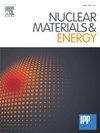Behavior of low alloy reactor pressure boundary steels in the loading range relevant for severe accidents and implications for material modeling in FE analyses
IF 2.3
2区 物理与天体物理
Q1 NUCLEAR SCIENCE & TECHNOLOGY
引用次数: 0
Abstract
This work presents a comprehensive compilation of material data and knowledge on the behavior of low alloy reactor pressure boundary steels, including SA533B1, SA508 Gr.3, 16MND5, 20 MnMoNi 5 5, 19MnNiMo, 22 NiMoCr 3 7, 15Kh2MFA and 15Kh2NMFA in the severe accident loading range. These data were compiled within the scope of the recently finished OECD/NEA CSNI WGIAGE/WGAMA activity on a Status Report on the RPV Integrity Assessment for In-Vessel Retention and include new results from different recent test campaigns. The data is compared and interpreted, revealing particularities in the extreme loading range, such as a relation between short-term creep and tensile deformation, as well as similarities between steel grades. Relevant factors of influence on deformation, damage and failure behavior are identified, and potential sources of scatter and uncertainties are discussed and quantified. The data confirm the assumption that loss of external cross-section is a principal mechanism of damage and failure in the relevant loading range due to the high ductility. Based on the findings, implications about material modeling in Finite Element codes are drawn and best practices are proposed. These include the choice between classical and constitutive models, the choice of deformation laws, the consideration of primary, secondary and/or tertiary creep, potential pitfalls as well as the selection of suitable failure criteria for relevant failure mechanisms.
求助全文
约1分钟内获得全文
求助全文
来源期刊

Nuclear Materials and Energy
Materials Science-Materials Science (miscellaneous)
CiteScore
3.70
自引率
15.40%
发文量
175
审稿时长
20 weeks
期刊介绍:
The open-access journal Nuclear Materials and Energy is devoted to the growing field of research for material application in the production of nuclear energy. Nuclear Materials and Energy publishes original research articles of up to 6 pages in length.
 求助内容:
求助内容: 应助结果提醒方式:
应助结果提醒方式:


